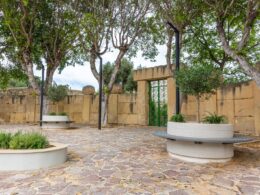This 1987 home in Mill Valley, California, was revitalised and is a standout example of architectural rejuvenation, fusing modern elegance and natural harmony
Located on a tranquil hillside, this home was transformed through the visionary redesign of architect Mason Kirby, who moved beyond structural change to demonstrate architecture’s role in addressing challenges, harmonising with landscapes and enhancing human interaction.
Trapeze Swinger, as the project is named, illustrates Kirby’s ability to rethink space and structure, proving architecture’s power in evolving living environments.




A spacious home, with four bedrooms, bathrooms and a six-car garage, it was transformed into a modern sanctuary that harmonises contemporary elegance with its environment.
Kirby’s design extends living spaces outdoors, with cathedral ceilings and decks that promote an open connection to nature.
The interior, with its floor-to-ceiling windows, showcases views of Mount Tamalpais, Sausalito, and the San Francisco skyline, connecting the homeowners with nature.
Through “transmutative design” and a keen emphasis on both form and function, the project melds beauty with practical utility, ensuring a harmonious integration with the surrounding landscape.
It is a testament to the evolutionary power of architecture, going beyond aesthetics to enhance the building’s relationship with its site.
By reimagining the existing building to enhance functionality and integration with the landscape, it underscores the impact through simplicity of form, Kirby said.


“The essence of design lies beyond aesthetic appeal; it dwells on the intricacies of… perspectives and the profound relationship between a structure and its landscape,” the architect explains.
“Trapeze Swinger illuminates these facets of architectural invention, serving as an example of how architecture can address and restate the challenges inherent in pre-existing buildings.”
The project showcases how architecture can overcome these pre-existing building challenges by recognising and unlocking compositional opportunities that more firmly set the structure within its surroundings.
Kirby’s renovation involved a detailed analysis of the home’s original layout, opting for strategic modifications over complete reconstruction.
This respectful dialogue with the site enhanced the home’s foundational elements, breathing new vitality into the space through careful refinement.
Good architecture involves amplifying a space’s inherent qualities to transform it significantly, Kirby believes.


“This project showcases architecture’s power to fundamentally reimagine a building’s essence, not merely its appearance,” he says.
Kirby highlights architectural problem-solving with scale, perspective and site integration, vital for harmonising built environments with their natural settings.
Strategic changes, like extending rooflines and adjusting window sizes, go beyond aesthetics to enhance the building’s relationship with its site. These modifications emphasise architecture’s role in shaping how buildings interact with their surroundings and the experience of their inhabitants.

Moreover, spatial connections within the home have shifted space perception. Strategic window placements and layout adjustments have maximised views and natural light, enriching the indoor-outdoor experience and elevating the overall living quality.
Trapeze Swinger stands as a testament to the power of architecture to create spaces that not only engage with, but also enhance, our interaction with the natural environment.










